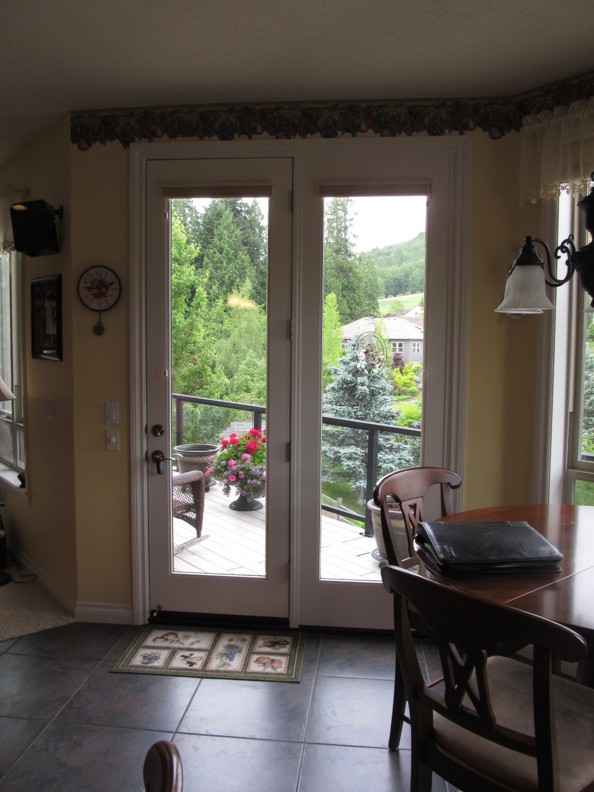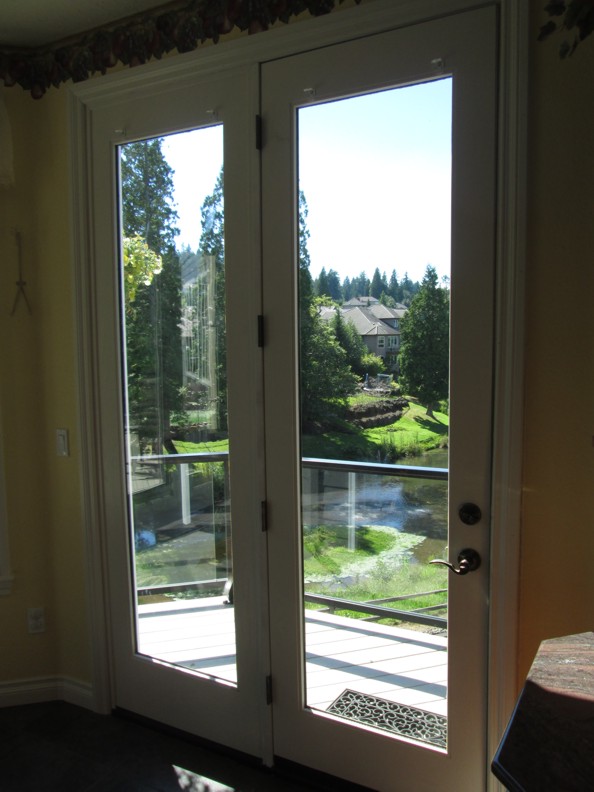|

A previous client in Gresham. Now this may sound questionable to some, but we replaced these very same door assemblies in 2006.
|

This is one of two sets of doors we previously installed. And the original doors we originally replaced were wood doors that did not last long at all given the extreme exposure these openings endure. We had recommended Fiberglass doors as being more up to the task of enduring the elements, which is what we installed in 2006.
|

And, as it would happen, the Fiberglass doors had indeed weathered quite well. But as you can see by these photos, the jambs and the center mull-posts were NOT a composite material, and just within the course of the 6 or 7 years, this is what the extreme weather blowing in from the Columbia Gorge had wrought.
|

All of the vertical jamb legs were showing some degree of this phenomenon wherein the caulking seams had opened up, due to the expansion and contraction of the wood-jambs, which subsequently allowed moisture to access the end grain at the bottom of these hemlock products, resulting in what is shown here as well-entrenched rot. Note the wavy surfaces and the split. Note the brickmoulding pulled away from the jambs. This is what can happen to even well-painted wood that is consistently drenched.
|

Fortunately for us, our clients here were of the reasonable variety…able to maintain sight of the fact that we did not design or build the door-jambs, nor the architecture of the house that left openings so severely exposed. So once again, they employed us to make the necessary repairs.
|

As it would happen, the advent and availability of “composite” door jambs had greatly increased since we installed the doors in 2006, so we were able to rehang the Fiberglass doors into new composite jambs. Steve Hilt is shown here routing hinge mortises into the new jambs on-site in our client’s garage.
|

After which, the door assemblies are reassembled and reinstalled.
|

The masking-tape you see here is indicative of the measures we take to not only provide a thorough caulking of all exterior joints and seams, but an entirely professional looking caulking job as well. You can enlarge the photo for a closer look. There are no doubt caulkers out there who might be tempted to brag about how they don’t need masking tape to achieve a professional looking caulking job, to which we would likely say… “whatever.”
|

The masking tape allows us opportunity to “tool” (apply pressure to) the caulking, working it into the joints and seams instead of the caulking merely sitting on the surface. This practice generally translates into a degree of smearing the caulking. The masking tape, as the name suggests, “masks” that effect and keeps the application of the caulking looking uniform and professionally applied, as David Castro demonstrates above with great finesse.
|

Yes, it takes more time and effort to do it this way, but this is quite simply the standard of work we aspire to provide.
Our client now has both doors and jambs (door-frames) that are impervious to the elements. And yes, the exterior brickmoulding we provided and installed is also a composite product. This is the second set of doors upstairs, as you can tell by which side of the opening the operable door sits on.
|
|
|